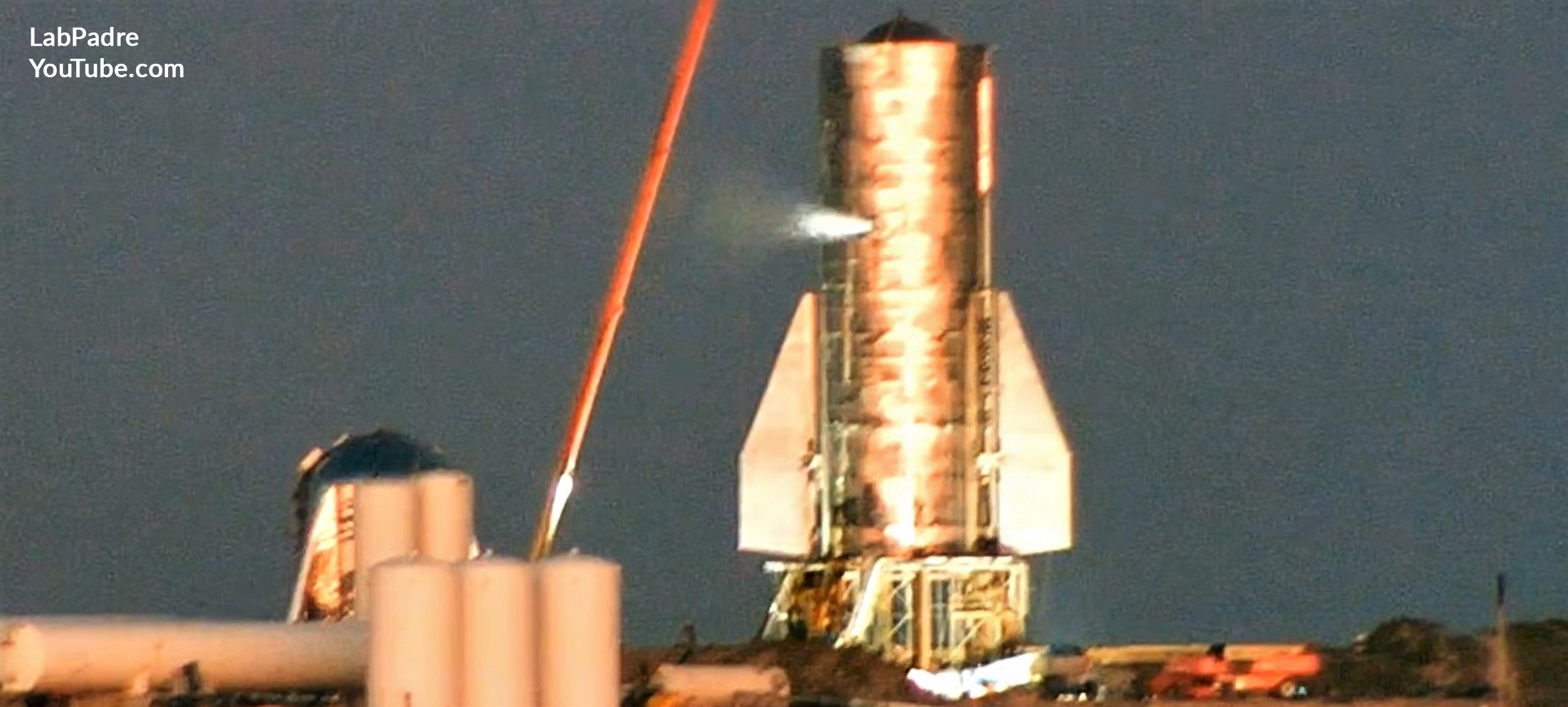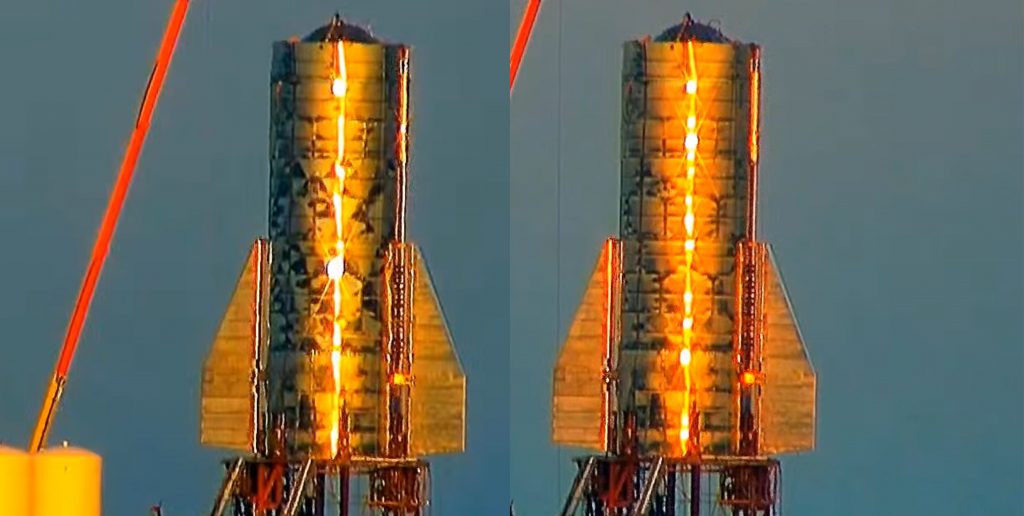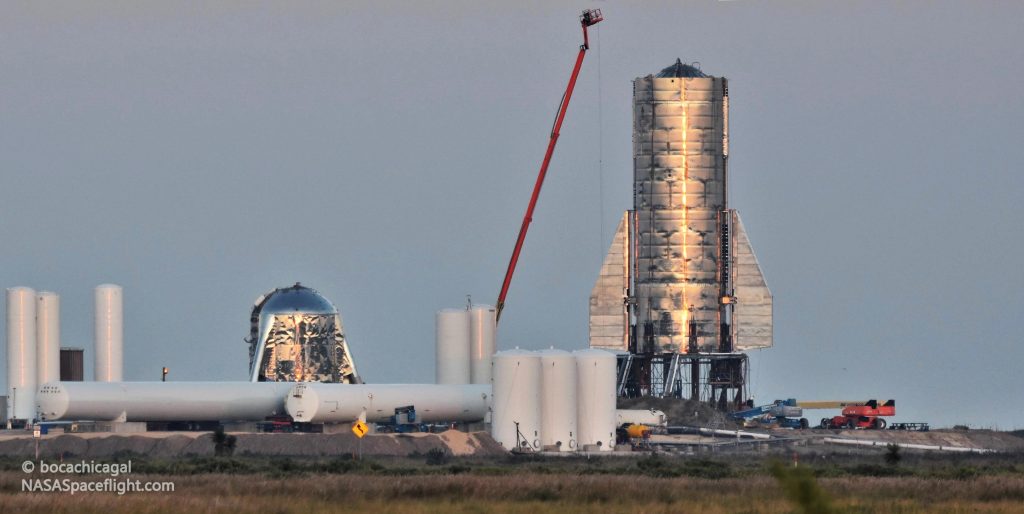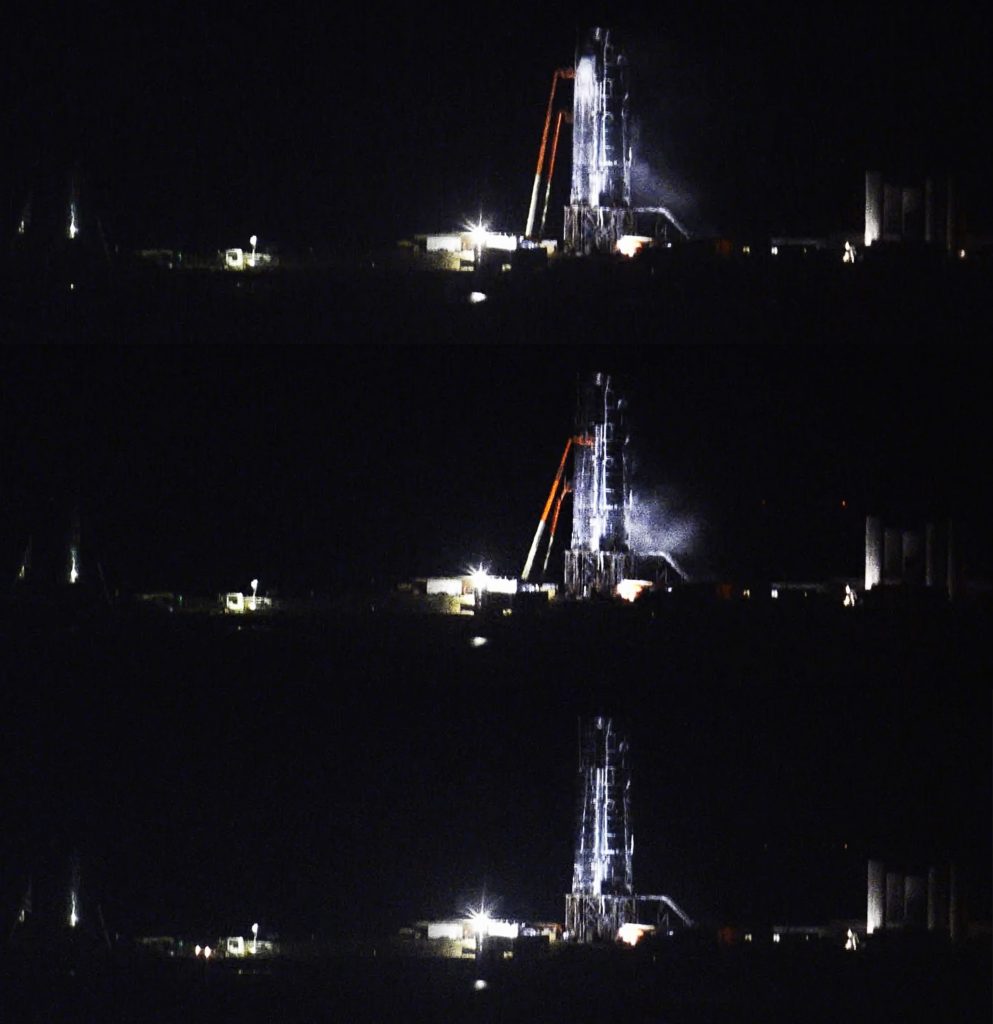

News
SpaceX’s Starship comes to life for the first time in lead-up to launch debut
For the first time ever, SpaceX has pressurized Starship Mk1’s building-sized propellant tanks, a critical test that culminated in the rocket prototype essentially taking its first ‘breaths’.
An anthropomorphization sometimes used to describe the venting launch vehicles often exhibit while during and after fueling, Starship Mk1’s so-called ‘breaths’ occurred around 5:59 pm CST (23:59 UTC). Those first vents came after roughly an hour or two spent performing several different pressurization cycles, observable due to the fact that Starship’s stainless steel tanks visibly smoothed out as pressure increased.

Due to the typical distances Starship is viewed from and the nature of the mirror-finished stainless steel SpaceX has chosen to build the next-generation launch vehicle out of, the exterior of Starship prototypes can produce a reflection that looks bumpy and disjointed. This has lead many a layperson to incorrectly assume that SpaceX’s Starship prototypes are thus shoddily built. In reality, viewed from afar, the tiniest hint of surface heterogeneity on a mirror can dramatically change what is reflected on its surface.
Even at the thinness of Starship Mk1’s liquid oxygen and methane tanks, stainless steel is still extremely strong, but pressurizing the vehicle’s tanks can clearly counteract a significant portion of the slight imperfections in their curvature.
Although it’s now clear that SpaceX did in fact perform some kind of pressurization test with Starship Mk1, it remains to be seen what exactly the nature of that testing was. First and foremost, SpaceX did establish significant roadblocks almost six hours before testing began, and company workers vacated the launch site several hours before visible Starship pressurization and venting. Fairly soon after that vent, workers returned to the pad and may or may not have been present during additional (but more subdued) venting activity.
Most importantly, November 18th’s testing featured a sum total of zero visible activity at SpaceX’s nearby flare stack, a mechanism used to burn waste methane gas to prevent dangerous buildups at worksites (or launch pads). This almost certainly means that methane (gaseous or liquid) played no role in pressurizing Starship Mk1’s propellant tanks.

Altogether, that likely means that Monday’s proof test was not a wet dress rehearsal (WDR), a term used to describe the process of testing a launch vehicle by fully fueling it and performing a countdown identical to a real launch – but without engine ignition or liftoff. Instead, SpaceX likely began the day’s testing by pressurizing Starship several times with a neutral gas like nitrogen or helium, while gaseous oxygen is also a possibility but is significantly less likely. Simply by using pressure sensors on Starship and knowing the volume of gas that is being loaded, SpaceX could likely determine whether the prototype has any leaks.
The major vent around 6 pm local time could have simply been Starship venting that pressurant gas, which would explain why there was just a single large, observable vent. When dealing with cryogenic liquid propellant, those supercool liquids gradually heat up, causing a portion to boil and turn into gas, gas that launch vehicles then vent intermittently to prevent overpressure events (i.e. explosions). Starship Mk1 only visibly vented once, although there may have also been some additional venting even after technicians returned to the launch site (another sign that the pressurant was neither toxic or combustible).

Oddly, shortly after SpaceX workers returned to the launch pad, they appeared to begin spraying down Starship Mk1 with a large volume of water or foam, producing clouds of mist as large as Starship itself. This came as a total surprise and why it’s being done is entirely unclear. Possible explanations include simply rinsing Starship (but why and why now?), checking its tanks for leaks, applying industrial quantities of WD40 (used to protect stainless steel from rust), or maybe even testing how Starship stands up to ice (extremely unlikely as it would need to be filled with a cryogenic liquid to be cold enough).
Perhaps the morning light will bring some answers. All things considered, as long as the mysterious spraying is not indicative of any serious issues or concerns with Starship Mk1, SpaceX may now be ready to put the prototype through a true propellant loading test, potentially filling its tanks with as much as 1200 metric tons (2.65 million pounds) of liquid oxygen and methane. If or when Starship passes that test, it’s next trial will be the very first triple-Raptor-engine static fire test. For now, we wait.
Check out Teslarati’s Marketplace! We offer Tesla accessories, including for the Tesla Cybertruck and Tesla Model 3.
Elon Musk
Tesla begins expanding Robotaxi access: here’s how you can ride
You can ride in a Tesla Robotaxi by heading to its website and filling out the interest form. The company is hand-picking some of those who have done this to gain access to the fleet.

Tesla has begun expanding Robotaxi access beyond the initial small group it offered rides to in late June, as it launched the driverless platform in Austin, Texas.
The small group of people enjoying the Robotaxi ride-hailing service is now growing, as several Austin-area residents are receiving invitations to test out the platform for themselves.
The first rides took place on June 22, and despite a very small number of very manageable and expected hiccups, Tesla Robotaxi was widely successful with its launch.
Tesla Robotaxi riders tout ‘smooth’ experience in first reviews of driverless service launch
However, Tesla is expanding the availability of the ride-hailing service to those living in Austin and its surrounding areas, hoping to gather more data and provide access to those who will utilize it on a daily basis.
Many of the people Tesla initially invited, including us, are not local to the Austin area.
There are a handful of people who are, but Tesla was evidently looking for more stable data collection, as many of those early invitees headed back to where they live.
The first handful of invitations in the second round of the Robotaxi platform’s Early Access Program are heading out to Austin locals:
I just got a @robotaxi invite! Super excited to go try the service out! pic.twitter.com/n9mN35KKFU
— Ethan McKanna (@ethanmckanna) July 1, 2025
Tesla likely saw an influx of data during the first week, as many traveled far and wide to say they were among the first to test the Robotaxi platform.
Now that the first week and a half of testing is over, Tesla is expanding invites to others. Many of those who have been chosen to gain access to the Robotaxi app and the ride-hailing service state that they simply filled out the interest form on the Robotaxi page of Tesla’s website.
That’s the easiest way you will also gain access, so be sure to fill out that form if you have any interest in riding in Robotaxi.
Tesla will continue to utilize data accumulated from these rides to enable more progress, and eventually, it will lead to even more people being able to hail rides from the driverless platform.
With more success, Tesla will start to phase out some of the Safety Monitors and Supervisors it is using to ensure things run smoothly. CEO Elon Musk said Tesla could start increasing the number of Robotaxis to monitors within the next couple of months.
Elon Musk
Tesla analyst issues stern warning to investors: forget Trump-Musk feud

A Tesla analyst today said that investors should not lose sight of what is truly important in the grand scheme of being a shareholder, and that any near-term drama between CEO Elon Musk and U.S. President Donald Trump should not outshine the progress made by the company.
Gene Munster of Deepwater Management said that Tesla’s progress in autonomy is a much larger influence and a significantly bigger part of the company’s story than any disagreement between political policies.
Munster appeared on CNBC‘s “Closing Bell” yesterday to reiterate this point:
“One thing that is critical for Tesla investors to remember is that what’s going on with the business, with autonomy, the progress that they’re making, albeit early, is much bigger than any feud that is going to happen week-to-week between the President and Elon. So, I understand the reaction, but ultimately, I think that cooler heads will prevail. If they don’t, autonomy is still coming, one way or the other.”
BREAKING: GENE MUNSTER SAYS — $TSLA AUTONOMY IS “MUCH BIGGER” THAN ANY FEUD 👀
He says robotaxis are coming regardless ! pic.twitter.com/ytpPcwUTFy
— TheSonOfWalkley (@TheSonOfWalkley) July 2, 2025
This is a point that other analysts like Dan Ives of Wedbush and Cathie Wood of ARK Invest also made yesterday.
On two occasions over the past month, Musk and President Trump have gotten involved in a very public disagreement over the “Big Beautiful Bill,” which officially passed through the Senate yesterday and is making its way to the House of Representatives.
Musk is upset with the spending in the bill, while President Trump continues to reiterate that the Tesla CEO is only frustrated with the removal of an “EV mandate,” which does not exist federally, nor is it something Musk has expressed any frustration with.
In fact, Musk has pushed back against keeping federal subsidies for EVs, as long as gas and oil subsidies are also removed.
Nevertheless, Ives and Wood both said yesterday that they believe the political hardship between Musk and President Trump will pass because both realize the world is a better place with them on the same team.
Munster’s perspective is that, even though Musk’s feud with President Trump could apply near-term pressure to the stock, the company’s progress in autonomy is an indication that, in the long term, Tesla is set up to succeed.
Tesla launched its Robotaxi platform in Austin on June 22 and is expanding access to more members of the public. Austin residents are now reporting that they have been invited to join the program.
Elon Musk
Tesla surges following better-than-expected delivery report
Tesla saw some positive momentum during trading hours as it reported its deliveries for Q2.

Tesla (NASDAQ: TSLA) surged over four percent on Wednesday morning after the company reported better-than-expected deliveries. It was nearly right on consensus estimations, as Wall Street predicted the company would deliver 385,000 cars in Q2.
Tesla reported that it delivered 384,122 vehicles in Q2. Many, including those inside the Tesla community, were anticipating deliveries in the 340,000 to 360,000 range, while Wall Street seemed to get it just right.
Tesla delivers 384,000 vehicles in Q2 2025, deploys 9.6 GWh in energy storage
Despite Tesla meeting consensus estimations, there were real concerns about what the company would report for Q2.
There were reportedly brief pauses in production at Gigafactory Texas during the quarter and the ramp of the new Model Y configuration across the globe were expected to provide headwinds for the EV maker during the quarter.
At noon on the East Coast, Tesla shares were up about 4.5 percent.
It is expected that Tesla will likely equal the number of deliveries it completed in both of the past two years.
It has hovered at the 1.8 million mark since 2023, and it seems it is right on pace to match that once again. Early last year, Tesla said that annual growth would be “notably lower” than expected due to its development of a new vehicle platform, which will enable more affordable models to be offered to the public.
These cars are expected to be unveiled at some point this year, as Tesla said they were “on track” to be produced in the first half of the year. Tesla has yet to unveil these vehicle designs to the public.
Dan Ives of Wedbush said in a note to investors this morning that the company’s rebound in China in June reflects good things to come, especially given the Model Y and its ramp across the world.
He also said that Musk’s commitment to the company and return from politics played a major role in the company’s performance in Q2:
“If Musk continues to lead and remain in the driver’s seat, we believe Tesla is on a path to an accelerated growth path over the coming years with deliveries expected to ramp in the back-half of 2025 following the Model Y refresh cycle.”
Ives maintained his $500 price target and the ‘Outperform’ rating he held on the stock:
“Tesla’s future is in many ways the brightest it’s ever been in our view given autonomous, FSD, robotics, and many other technology innovations now on the horizon with 90% of the valuation being driven by autonomous and robotics over the coming years but Musk needs to focus on driving Tesla and not putting his political views first. We maintain our OUTPERFORM and $500 PT.”
Moving forward, investors will look to see some gradual growth over the next few quarters. At worst, Tesla should look to match 2023 and 2024 full-year delivery figures, which could be beaten if the automaker can offer those affordable models by the end of the year.
-

 Elon Musk2 days ago
Elon Musk2 days agoTesla investors will be shocked by Jim Cramer’s latest assessment
-

 News1 week ago
News1 week agoTesla Robotaxi’s biggest challenge seems to be this one thing
-

 Elon Musk2 weeks ago
Elon Musk2 weeks agoElon Musk slams Bloomberg’s shocking xAI cash burn claims
-

 News2 weeks ago
News2 weeks agoTexas lawmakers urge Tesla to delay Austin robotaxi launch to September
-

 Elon Musk1 week ago
Elon Musk1 week agoFirst Look at Tesla’s Robotaxi App: features, design, and more
-

 Elon Musk2 weeks ago
Elon Musk2 weeks agoTesla Robotaxis are becoming a common sight on Austin’s public roads
-

 Elon Musk2 weeks ago
Elon Musk2 weeks agoSpaceX President meets India Minister after Starlink approval
-

 Elon Musk2 weeks ago
Elon Musk2 weeks agoxAI’s Grok 3 partners with Oracle Cloud for corporate AI innovation

















